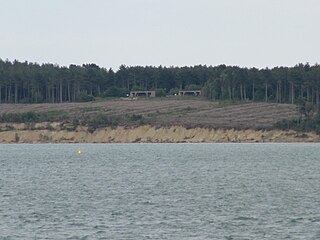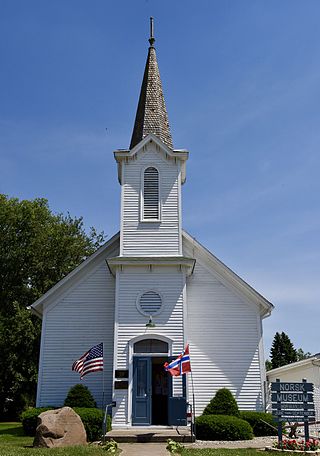Related Research Articles

The Mesolithic or Middle Stone Age is the Old World archaeological period between the Upper Paleolithic and the Neolithic. The term Epipaleolithic is often used synonymously, especially for outside northern Europe, and for the corresponding period in the Levant and Caucasus. The Mesolithic has different time spans in different parts of Eurasia. It refers to the final period of hunter-gatherer cultures in Europe and Middle East, between the end of the Last Glacial Maximum and the Neolithic Revolution. In Europe it spans roughly 15,000 to 5,000 BP; in the Middle East roughly 20,000 to 10,000 BP. The term is less used of areas farther east, and not at all beyond Eurasia and North Africa.

Ski is a town and former municipality in the new municipality of Nordre Follo in the greater region Follo, in Viken county, Norway.

Oppegård is an area in Nordre Follo, Viken, Norway. Oppegård was a municipality in the former county Akershus.

Star Carr is a Mesolithic archaeological site in North Yorkshire, England. It is around five miles (8 km) south of Scarborough. It is generally regarded as the most important and informative Mesolithic site in Great Britain. It is as important to the Mesolithic period as Stonehenge is to the Neolithic period or Scandinavian York is to understanding Viking Age Britain.

Maglemosian is the name given to a culture of the early Mesolithic period in Northern Europe. In Scandinavia, the culture was succeeded by the Kongemose culture.

Archaeology and geology continue to reveal the secrets of prehistoric Scotland, uncovering a complex past before the Romans brought Scotland into the scope of recorded history. Successive human cultures tended to be spread across Europe or further afield, but focusing on this particular geographical area sheds light on the origin of the widespread remains and monuments in Scotland, and on the background to the history of Scotland.
The Komsa culture (Komsakulturen) was a Mesolithic culture of hunter-gatherers that existed from around 10,000 BC in Northern Norway.

The Fosna/Hensbacka, were two very similar Late Palaeolithic/early Mesolithic cultures in Scandinavia, and are often subsumed under the name Fosna–Hensbacka culture. This complex includes the Komsa culture that, notwithstanding different types of tools, is also considered to be a part of the Fosna culture group. The main difference is that the Fosna/Komsa culture was distributed along the coast of Northern Norway, whereas the Hensbacka culture had a more eastern distribution along the coast of western Sweden; primarily in central Bohuslän to the north of Gothenburg. The Hensbacka culture evolved into the later Sandarna culture which is found along the coast of western Sweden.

The Ahrensburg culture or Ahrensburgian was a late Upper Paleolithic nomadic hunter culture in north-central Europe during the Younger Dryas, the last spell of cold at the end of the Weichsel glaciation resulting in deforestation and the formation of a tundra with bushy arctic white birch and rowan. The most important prey was the wild reindeer. The earliest definite finds of arrow and bow date to this culture, though these weapons might have been invented earlier. The Ahrensburgian was preceded by the Hamburg and Federmesser cultures and superseded by the Maglemosian and Swiderian cultures. Ahrensburgian finds were made in southern and western Scandinavia, the North German plain and western Poland. The Ahrensburgian area also included vast stretches of land now at the bottom of the North and Baltic Sea, since during the Younger Dryas the coastline took a much more northern course than today.

The Hamburg culture or Hamburgian was a Late Upper Paleolithic culture of reindeer hunters in northwestern Europe during the last part of the Weichsel Glaciation beginning during the Bölling interstadial. Sites are found close to the ice caps of the time. They extend as far north as the Pomeranian ice margin.

The Nordic Stone Age refers to the Stone Age of Scandinavia. During the Weichselian glaciation, almost all of Scandinavia was buried beneath a thick permanent ice cover, thus, the Stone Age came rather late to this region. As the climate slowly warmed up by the end of the ice age, nomadic hunters from central Europe sporadically visited the region. However, it was not until around 12,000 BCE that permanent, but nomadic, habitation in the region took root.

Prehistoric Wales in terms of human settlements covers the period from about 230,000 years ago, the date attributed to the earliest human remains found in what is now Wales, to the year AD 48 when the Roman army began a military campaign against one of the Welsh tribes. Traditionally, historians have believed that successive waves of immigrants brought different cultures into the area, largely replacing the previous inhabitants, with the last wave of immigrants being the Celts. However, studies of population genetics now suggest that this may not be true, and that immigration was on a smaller scale.
The prehistory of the County of Norfolk, England is broken into specific time periods, these being Palaeolithic, Mesolithic and Neolithic.

Pulli settlement, located on the right bank of the Pärnu River, is the oldest known human settlement in Estonia. It is two kilometers from the town of Sindi, which is 14 kilometers from Pärnu. According to radiocarbon dating, Pulli was settled around 11,000 years ago, at the beginning of the 9th millennium BC. A dog tooth found at the Pulli settlement is the first evidence for the existence of the domesticated dog in the territory of Estonia.

Bouldnor Cliff is a submerged prehistoric settlement site in the Solent. The site dates from the Mesolithic era and is in approximately 11 metres of water just offshore of the village of Bouldnor on the Isle of Wight in the United Kingdom. The preservation of organic materials from this era that do not normally survive on dry land has made Bouldnor important to the understanding of Mesolithic Britain, and the BBC Radio 4's Making History programme described it "probably Europe's most important Mesolithic site" albeit concealed under water.

Norway is an unincorporated community in Mission Township, LaSalle County, Illinois. Located along the Fox River, the community was the site of an early Norwegian-American settlement. Today it is the site of the State of Illinois Norwegian Settlers Memorial.

The Swiderian culture is an Upper Palaeolithic/Mesolithic cultural complex, centred on the area of modern Poland. The type-site is Świdry Wielkie, in Otwock near the Swider River, a tributary to the Vistula River, in Masovia. The Swiderian is recognized as a distinctive culture that developed on the sand dunes left behind by the retreating glaciers. Rimantienė (1996) considered the relationship between Swiderian and Solutrean "outstanding, though also indirect", in contrast with the Bromme-Ahrensburg complex, for which she introduced the term "Baltic Magdalenian" for generalizing all other North European Late Paleolithic culture groups that have a common origin in Aurignacian.
The Sands of Beirut were a series of archaeological sites located on the coastline south of Beirut in Lebanon.

The discovery of artefacts at two excavation sites in 2010 revealed human settlement at Monmouth in the Mesolithic period. The artefacts uncovered by archaeologists at St James' Square and Wyebridge Street included charcoal, flints, and bone fragments. The discovery has led to the conclusion that the site of Monmouth, adjoining the confluence of the rivers Monnow and Wye in south east Wales, was inhabited thousands of years earlier than previously believed.
Tønnesminde is the site of an archaeological excavation ground and present day organic farm on the island of Samsø, Denmark. Archaeological evidence attests the area around Tønnesminde has a long history of human occupation, dating from approximately 4000 BC to present day. Recent excavations suggest that Tønnesminde contains settlements dating from the Funnelbeaker culture in the Early Neolithic period, Early Bronze Age, Pre-Roman Iron Age, and Viking Age.
References
- ↑ "Stunner. Ski herad. Akershus". Matrikkelutkastet av 1950. Retrieved August 15, 2016.
- ↑ Lil Gustafson (October 1996). "Steinalderboplassen På Stunner- 9500 år". Ski historielag. Retrieved August 15, 2016.
- ↑ Ingrid Fuglestvedt (1999) "The Early Mesolithic Site at Stunner, Southeast Norway: A Discussion of Late Upper Palaeolithic/Early Mesolithic Chronology and Cultural Relations in Scandinavia" in Joel Boaz (ed.), The Mesolithic of Central Scandinavia (Universitetets Oldsakssamling) ISBN 82-7181-152-5. 5. Artikkel. s 189 - 202
- ↑ Dr. Vincent H. Malmström. Professor Emeritus of Geography. "Norway Before the Vikings" (PDF). Dartmouth College. Archived from the original (PDF) on February 4, 2012. Retrieved August 15, 2016.
59°44′32″N10°55′24″E / 59.7422°N 10.9233°E